By Riccardo Mordeglia

Mario Maccaferri
I am writing this article at Michael’s request following some of our discussions on the birth of the Maccaferri guitar inserted in its historical, geographical and sociocultural context. It is a summary of my twenty-year research as a luthier of gypsy guitars, a resident of Maccaferri’s home of Ferrera, and as a sociologist.
In every creation myth, things always arise from nothing. However, we know from history that there are always precedents. In reality things never arise from nothing but are the result of the evolution of some preexisting thing. Musicians know this process well.
To begin, let’s contextualize Maccaferri in his geographical context. It is often said that Maccaferri was from Bologna, but this is not correct. He was from Cento, a town in the province of Ferrara. Certainly Bologna is the largest city in the vicinity and for those who are not familiar with the area it is easier to identify but technically it was in the Ferrara district and, beyond parochial or bureaucratic nonsense, this is very important for reasons that we will see later.
Maccaferri was therefore born in Cento, in the province of Ferrara in 1900, in an old mill of which his family was the custodian. Coincidentally, the mill was demolished in 1990, the year of Maccaferri’s death. It was replaced with, in my opinion, a horrible looking structure for residential and commercial use.
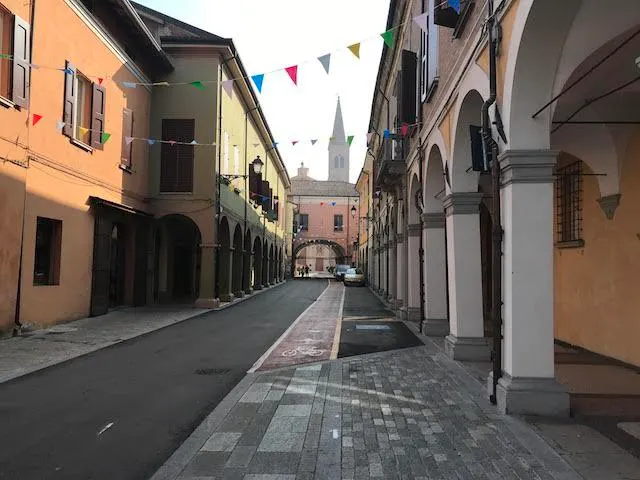
Cento
Cento is located in the culturally rich region of Emilia Romagna. Music from Emilia Romagna has always had a leading role in Italian culture and society. Important composers from Emilia Romagna include Corelli, Verdi, Frescobaldi, and Toscanini. Many top perfromers also hail from the region, but not only in the classical field but also in the field of musica leggera, which includes everything that is not classical (i.e. rock, pop, jazz, etc.) The most important singers, musicians and orchestral players in Italy are from Emilia. From all over Europe they come to our Riviera for the discos. In short, Emilia Romagna has always had a profound musical culture.
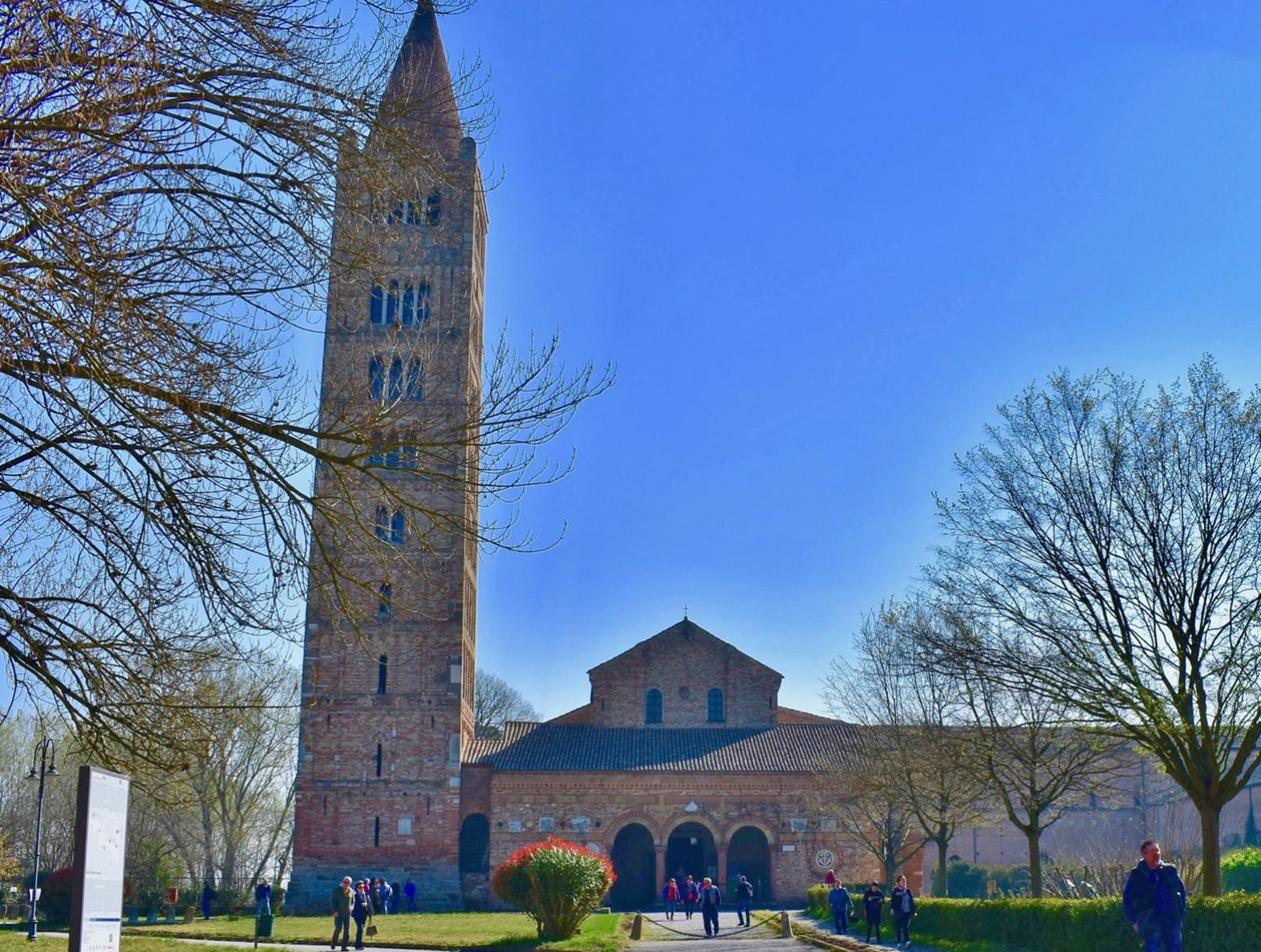
Pomposa Abbey
In Emilia Romagna, and to be precise in the Pomposa Abbey, in the province of Ferrara, modern musical notation and solfege was invented. Antonio Vivaldi would have liked to present his four seasons for the first time in Ferrara because of the importance it had, but he was prevented by the local bishop.
There is also a musical genre typical of Emilia Romagna, the liscio, a dance music in ¾ that includes waltzes, polkas, mazurkas, performed in an Italian key, for which it contains distant classical, operatic, medieval and Renaissance references. Liscio was born in the second half of the nineteenth century. In that period, and this is very important for our discussion, there was an important Austro-Hungarian military presence in the Ferrara area. This greatly influenced the culture of this area, including popular musical genres, which as we have said they were precisely the waltz, the polka and the mazurka, all of Austro-Hungarian origin. Musical instruments constructed in Emilia were also influenced by Austro-Hungarian culture.
At that time Italy was in the process of unification and in conflict with Austria, which controlled nearby Veneto, on the other side of the Po river, and saw this area as a borderland to be controlled militarily. In this period traditional music was born in Emilia Romagna. The first musicians, as in any folk musical context, were basically farmers and artisans who played in popular festivals, anniversaries, weddings and where there was a need for musical dance entertainment. These early ensembles were typically composed of a trio made up of double bass, violin and guitar. Subsequently some professional musicians dedicated themselves to this music, such as Carlo Brighi, the first violin of Toscanini’s orchestra, who introduced the clarinet.
Unfortunately today there are few testimonies of the so-called old liscio, just a couple of ethnomusicological collections and little more. This was due to fact that the musicians were generally not professionals, but rather were peasants, artisans and workers so they had no interest in recording discs. Furthermore, ballroom dancing was opposed both by the Catholic Church, which considered it too lascivious, as well as the Fascist regime which did not deem it to be purely Italian music. Liscio was also strongly associated with a communist political agenda. In the 1960s it had a kind of revival due to the “new liscio” by the Casadei family who hybridized it with pop music. Regardless, it continued to be looked down upon by the art music world. In fact, I remember in the 1980s a music teacher of mine, who had a classical music background, defined it as the pornography of music.
Between the late 1800s and early 1900s there was a strong musical development in Emilia Romagna both in the folk and cultured fields, and therefore there was also a demand for instruments. The Centese area was in some way strategic and attractive for the builders because it was geographically located between Bologna, Ferrara and Modena and was also developing economically. In fact, it is here that Lamborghini will be born years later. Luigi Mozzani, one of the greatest geniuses and innovators of guitar lutherie, as well as a great musician, then moved to this area from Faenza and after having traveled throughout Europe for his concert activity. Mario Maccaferri received his training in Mozzani’s workshop.
This area also has an important ethnic history to take into consideration: Ferrara, before the Second World War, was “the most Jewish city in Italy.” There was a strong Jewish presence here dating back to the 1500s. After the Jews were expelled from Spain, many were welcomed in the Ferrara area. The nobles of the time, in opposition to the Pope, allowed religious freedom. The Jewish presence was very substantial and culturally important in all areas of Ferrara’s life, from cuisine to language to art, so much so that it is said that Ferrara in the 16th century was equivalent to contemporary New York. In the universities of Bologna and Ferrara, Hebrew was also taught as a learned language in addition to Latin and Greek.
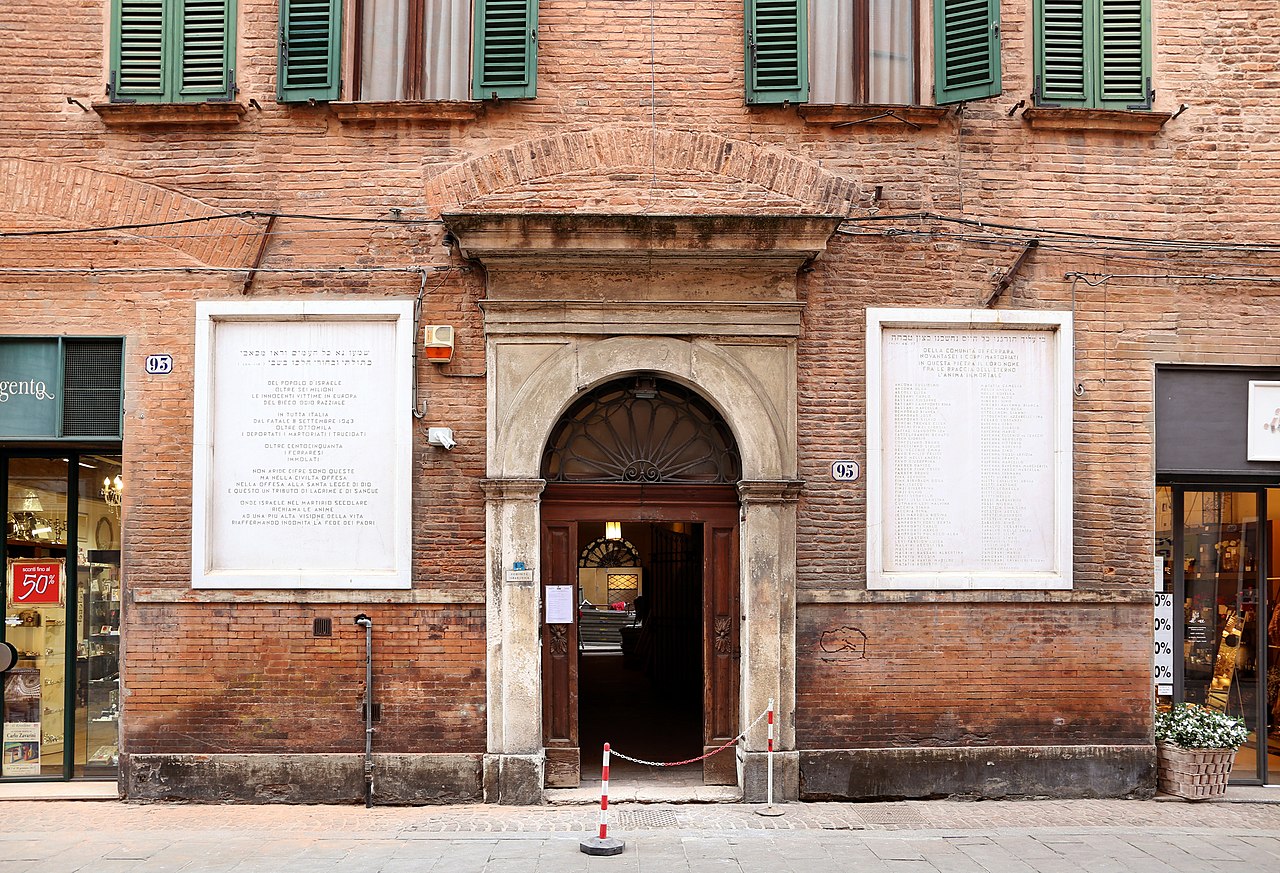
Ferrara Synagogue
It is interesting to note that the presence of stringed instruments in the Ferrara area dates back to the 1500s, probably brought by Jews from Spain. The same dialectal term for guitar is ghitara, with the g, in the Spanish manner. This could actually be due to the Ferrara phonetics which preserves some elements of the Lombard language, of Germanic origin, which favors the g sound, or it could also be due to a contamination between the languages, also considering that there is only one “r.” Some Ferrarese luthiers of past centuries had names of Jewish origin, as indeed many Ferrarese, given the widespread mixing of the Jewish and gentile populations. At the beginning of the 20th century, an artisan workshop of carpentry and lutherie of stringed instruments is located in the Jewish quarter near the synagogue. This doesn’t mean that the Jews made guitars or that it was their prerogative, as we don’t have any documentation. However, considering the history of Jewish instrument makers in this ares, it’s likely they had in influence in guitar making. Some have also theorized the same process of Jewish influence for the birth of the violin in the Lombard area.
Returning to the Austro-Hungarian soldiers, it must be said that these two cultural elements, Austrian and Jewish, somehow came together and created a kind of partnership since in 1700. Following revolts against the French who had occupied the city, some of the people wanted to take advantage of the confusion to go and plunder the Jewish quarter. The Jews were defended by the Austrians, who were then later hired by the Jews for protection.
We have therefore arrived at a first summary, we have these cultural elements that coalesce: a cultural predisposition of the population to music, an Austrian influence on genres, and a Jewish history of instrument building.
However, there is also another element that will influence Maccaferri, which is the centuries old Italian tradition of guitar making. Luthiers from Salerno also moved to this area at that time (unfortunately this is something I read in a document many years ago and I was no longer able to find it so I can’t cite the names and the source,) and clearly they also brought their building techniques and traditions with them.
The typical instrument of the southern Italian tradition is the chitarra battente, also called the Italian guitar by the Germans, precisely because it is a characteristic instrument of the southern Italian tradition. It is a folk version of the baroque guitar and retains some features of the baroque guitar such as the decorated rosette on the sound hole and the typically elongated shape. However, it differs from the baroque guitar in its use of metal strings, a heat-bent soundboard, and a floating bridge, all elements that we will later find in the Maccaferri guitar. These features evolved as a way to increase the volume of the guitar which were required in the folk ensembles for which it was primarily used.
The bending of chitarra battente’s top is usually achieved, as with the mandolin, by notching the inside and applying heat. However, chitarra battente from Salerno differs in not having this engraving and therefore has a softer curvature, similar to that of Maccaferri’s guitars.
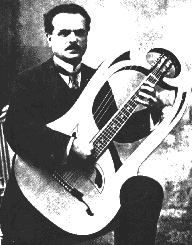
Luigi Mozzani
So when Mozzani settled here he built guitars modeled on Austrian designs, thanks to the fact that he himself also lived for a short time in Austria. However, the timbre was influenced by the Jewish musical sensibility that wanted a brilliant sound. In fact, from his notes we read how his research was aimed at increasing the treble response of the instrument.
Mozzani also took up the design of Austrian guitars, especially from Austrian harp guitars and wappenguitars. It is from these guitars that comes the characteristic design of the cutaway typical of gypsy guitars. Mozzani also opted for a wider body than is typical of classical guitars. This was the result of harp guitars requiring a wider bout to support more strings. The bracing also had to be reinforced to be able to withstand the strain of the additional bass.
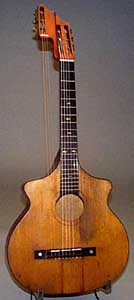
Mozzani Harp Guitar
However, Mozzani did not limit himself to imitating Austrian guitars. He made countless experiments to improve the tone and projection of his instruments. He experimented with bracing and pioneered revolutionary techniques such as double soundboards and double backs. To improve playability for the player he invented the bolt-on neck so that the height of the strings could be adjusted by the screws on the neck.
An amusing anecdote concerns Mozzani’s studies on bracing: he lived in a country house and, like all country houses around here, it had bars on the ground floor windows for safety reasons. In an attempt test bracing patterns, he cut and bent the window bars to have different patterns similar to guitar bracing, then hammered them to see which had the most resonance. We don’t know if this experiment led to any great acoustical insights, but there’s no doubt it angered his wife to no end! Many of these experiments were not successful but served as ideas for the work of Maccaferri who was inspired by Mozzani.
Going back a bit in time, another important thing must be mentioned for the development of the instruments which then led to the manouche guitar: the Gino Neri mandolin orchestra which began in Ferrara in 1898 and is still active today. At the time, the mandolin was considered the classic instrument for amateurs. The members of this orchestra were all craftsmen or traders with little or no musical knowledge but who enjoyed replicating an operatic repertoire with the mandolin. Mozzani collaborated deeply with this orchestra, arriving at the creation of a new type of flat or chiselled bottom mandolin which combined low production costs with excellent sound performance. He also designed a mandocello and a mandobass to complete the orchestra. Today this type of mandolin, despite having been invented in Ferrara, is also known as the Bolognese mandolin due to it’s popularity in Bologna. Bologna is full of arcades and, as in the narrow streets of Naples or Genoa, where the mandolin has found more fame, the arcades form a reverberant space in which the mandolin finds its optimal acoustics and natural sound amplification. The mandolin was used in the streets of Bologna to accompany liscio bolognese, a virtuous and almost acrobatic variant of liscio dancing.
Bologna is famous for its taverns were wine can be imbibed while enjoying music. These taverns typically have instruments on the walls that anyone could spontaneously use for an impromptu musical performance. Much of Bologna’s musical culture centered around the taverns which served as meeting places for musicians. Many local performers learned their trade and gained notoriety in the taverns.
In Mozzani’s era there was also another important guitar maker in this area, Masetti, in Modena.
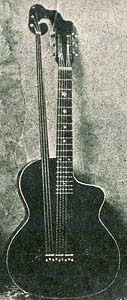
Masetti Harp Guitar
Among these three, Mozzani, Maccaferri and Masetti, there were some mutual good natured accusations of plagiarism. However, the similarities of their instruments were due more to mutual influence, so much so that it is not easy to understand who copied from whom.
Maccaferri opened his own instrument factory in Cento from 1923 to 1927. In this period he built violins, mandolins, and guitars, including harp guitars, and other models that he defined as “normal” and “normal cutaway.” His instruments won numerous prizes and awards in national and international competitions. Despite his success, business probably wasn’t going so well because Maccaferri then moved to Paris in August 1927, apparently on the advice of Mozzani himself. Maccaferri had an uncle in Paris who was an accordion dealer that employed him to do guitar and accordion repair as well as build violins. Alongside this work he also took guitar lessons and undertook a promising career as a musician. Having previously studied with Mozzani and at the Sienna Conservatory, Maccaferri became known as one of the leading exponents of the classical guitar, often spoken of in the same breath as Segovia. He made various records for Columbia and Odeon. His fame brought him to London where he was able to devote himself entirely to concerts and lessons.
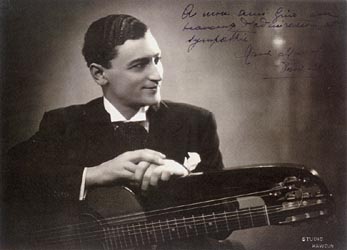
Mario Maccaferri
Despite his success as a performer, Maccaferri continued to pursue his interest in lutherie, with a keen desire to improve and modernize the guitar. A friend of his who worked in a furniture factory got him wood and tools and he began to make various experiments until he perfected his now legendary Concert model. The Selmer corporation was impressed with the design and, while they had no previous experience with string instruments, decided to put it into production. To meet the increasing demand for an instrument suitable for jazz, Selmer asked Maccaferri to reconfigure the Concert model for steel strings which gave birth to the steel strung Orchestra model.
These revolutionary new guitar designs make use of all the elements of guitar lutherie that Maccaferri had learned while in Ferrara. We have a guitar that, in terms of design, derives from Austrian guitars, with a fingerboard that extends like a mandolin. A resonator that was an evolution of Mozzani’s experiments with guitars with a double bottom or double soundboard. Even the bracing was an evolution of Mozzani’s experiments. For example, the model produced by Selmer with the name of Espanol was not because it was a Spanish guitar, but because that name indicated, at that time, a guitar capable of supporting both nylon and metal strings due to the reinforced bracing.
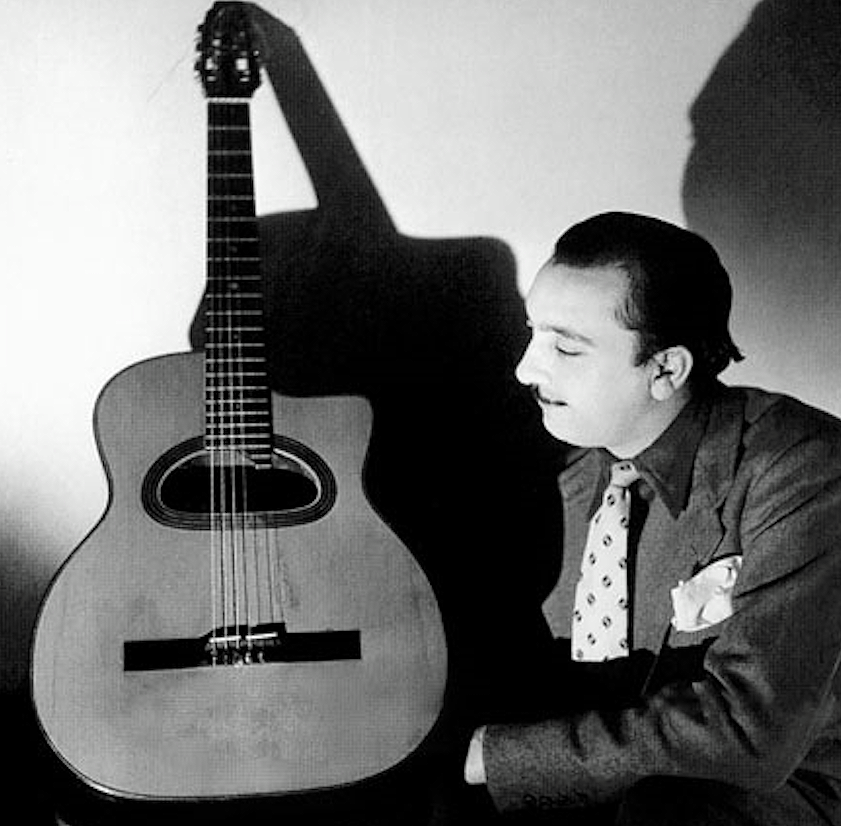
Django Reinhardt posing with a Concert model Selmer Maccaferri
The steel string model included pliage (i.e. a bent top) and a floating bridge, as in the chitarra battente. Years ago I had the opportunity to see a guitar built by the young Maccaferri in the Mozzani workshop, owned by the master luthier Guerriero Spataffi, founder of the Gubbio lutherie school, which had the typical elongated shape of the battente guitar, without a pliage, but with an elliptical sound hole and the classic cutaway typical of Maccaferri guitars. The pliage, even if it was used in the battente guitars of southern Italy, was not used in northern Italy for guitars, however it was used in the Ferrara countryside by non-professional builders to make cheap double basses for liscio orchestras. Also similar to Maccaferri’s guitar, these basses used ladder bracing to support string tension and shape the top.
Maccaferri’s innovative guitars produce the projection and bright tone required for playing at festivals or noisy clubs. It’s no wonder that Django Reinhardt immediately chose a Selmer Maccaferri as his primary instrument, later leading to its adoption by the gypsy community as a whole.
In 1933 Maccaferri left Selmer over a contractual dispute, and wanted to devote himself to the construction of reeds, but also resumed his career as a musician. However, an accident occurred on the set of the film La Folle Di Lac in which he broke his hand. The accident ended his performing career. Although, he may have had other reasons for wanting to retire from performing. His right hand was injured so he could have reinvented himself as a plectrum guitarist. Maccaferri held the title of “professor of plectrum” at the conservatory, so the skills were there. Regardless, it seems that he was simply tired of that life and wasn’t interested in adapting to the ever more popular style of jazz, a style that he didn’t like and didn’t understand, even though it’s success was partially due to the guitar that he himself designed.
There is one last point I would like to address: the characteristic D shaped soundhole design and the pointed shape of the headstock. They are so distinctive and so different from any other guitar that you have wonder “why?” A larger soundhole was necessary for the internal soundbox’s reflector. There are a number of shapes that could have worked, so why did he choose the distinctive D shape?
I have a theory why Maccaferri made this unusual choice. There was an ancient tradition, now in disuse, in Italian violin making of incorporating some of the architectural motifs of their region into their instruments in order to indicate the provenance of the maker and in some way the history of the instrument. In Baroque guitars, for example, the builders inserted elements of the stain glass window of the church of their own city in the soundhole. In the curl of the Cremona violins it is said that the curls of the facade of the city’s cathedral are referenced.
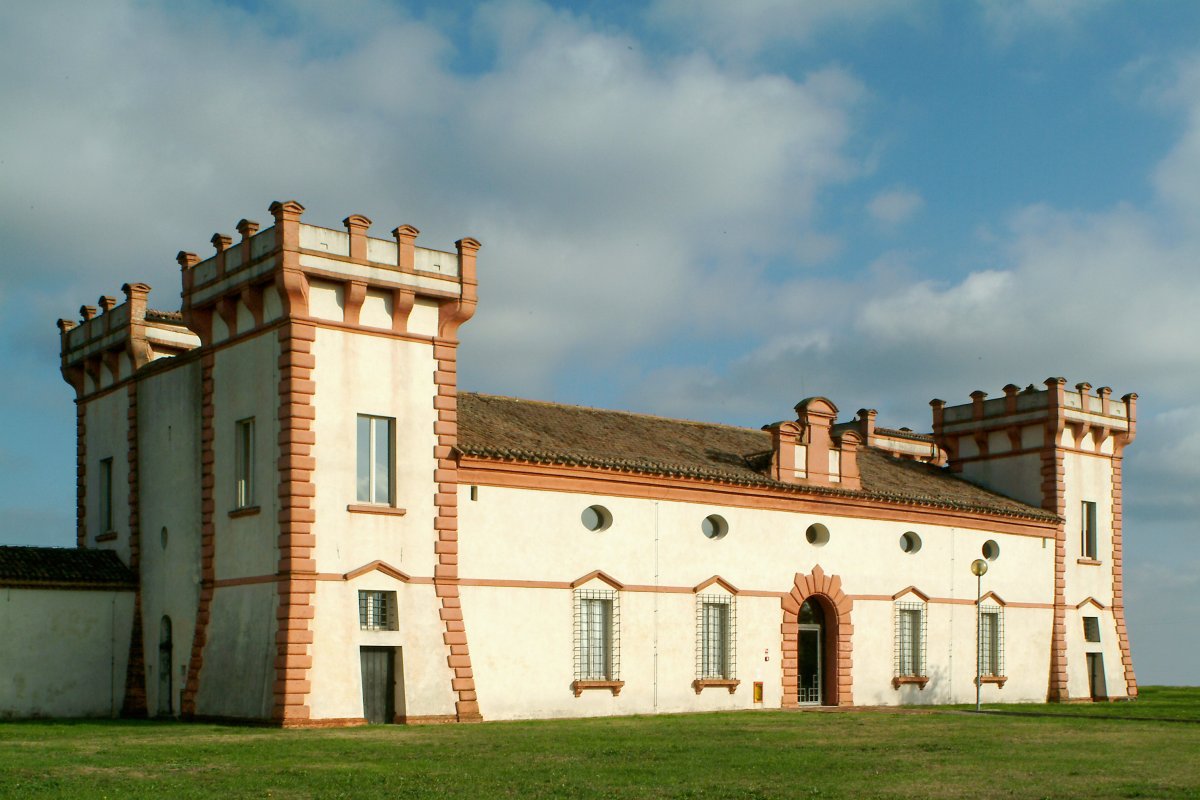
Verginese Castle
I have always suspected that Maccaferri’s guitars were at least partially inspired by this tradition. I studied the architecture of Ferrara for years looking for design features that may have served as inspiration. One day, after many years with no success, I was walking absentmindedly in front of the Verginese Castle,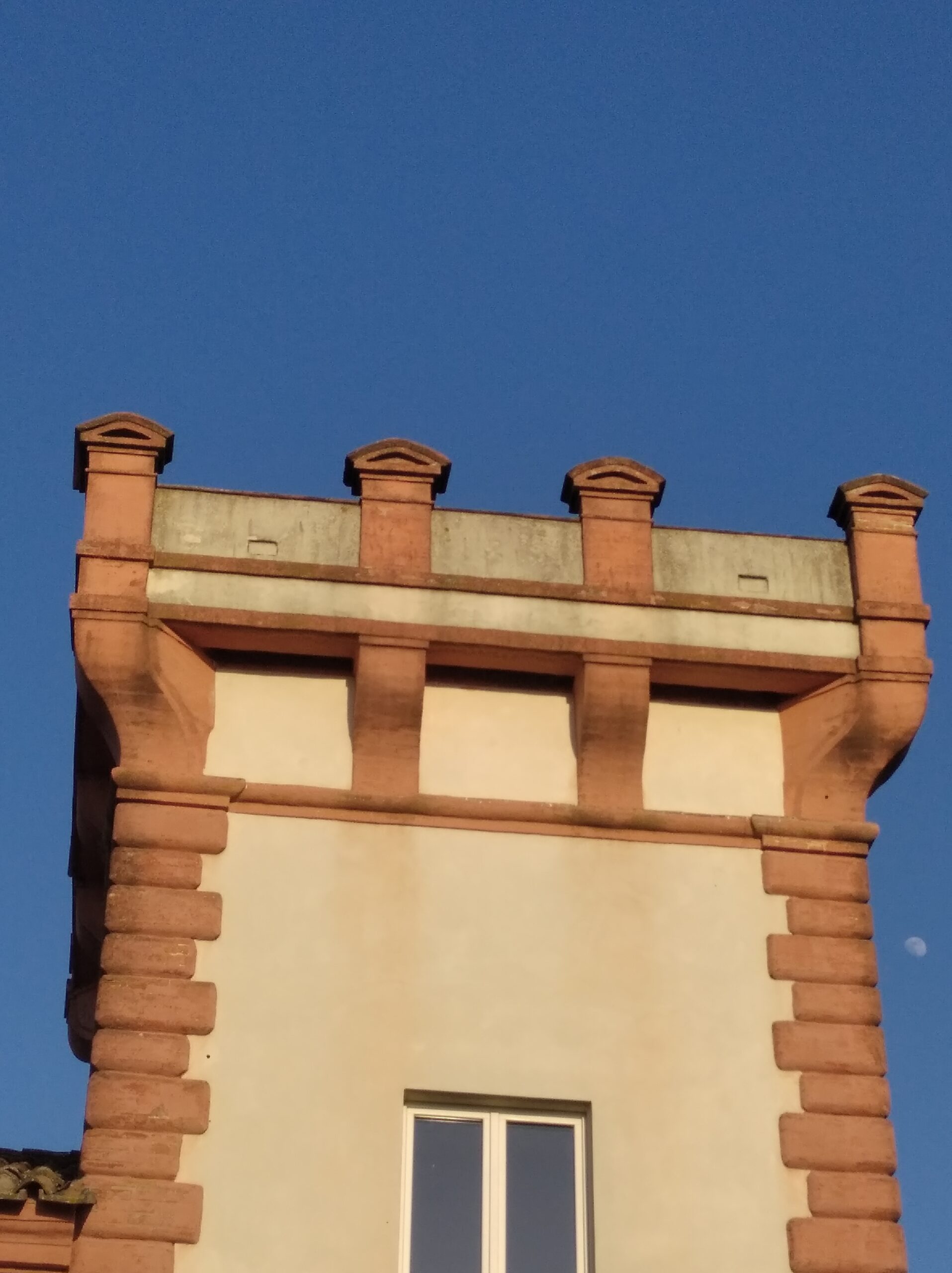
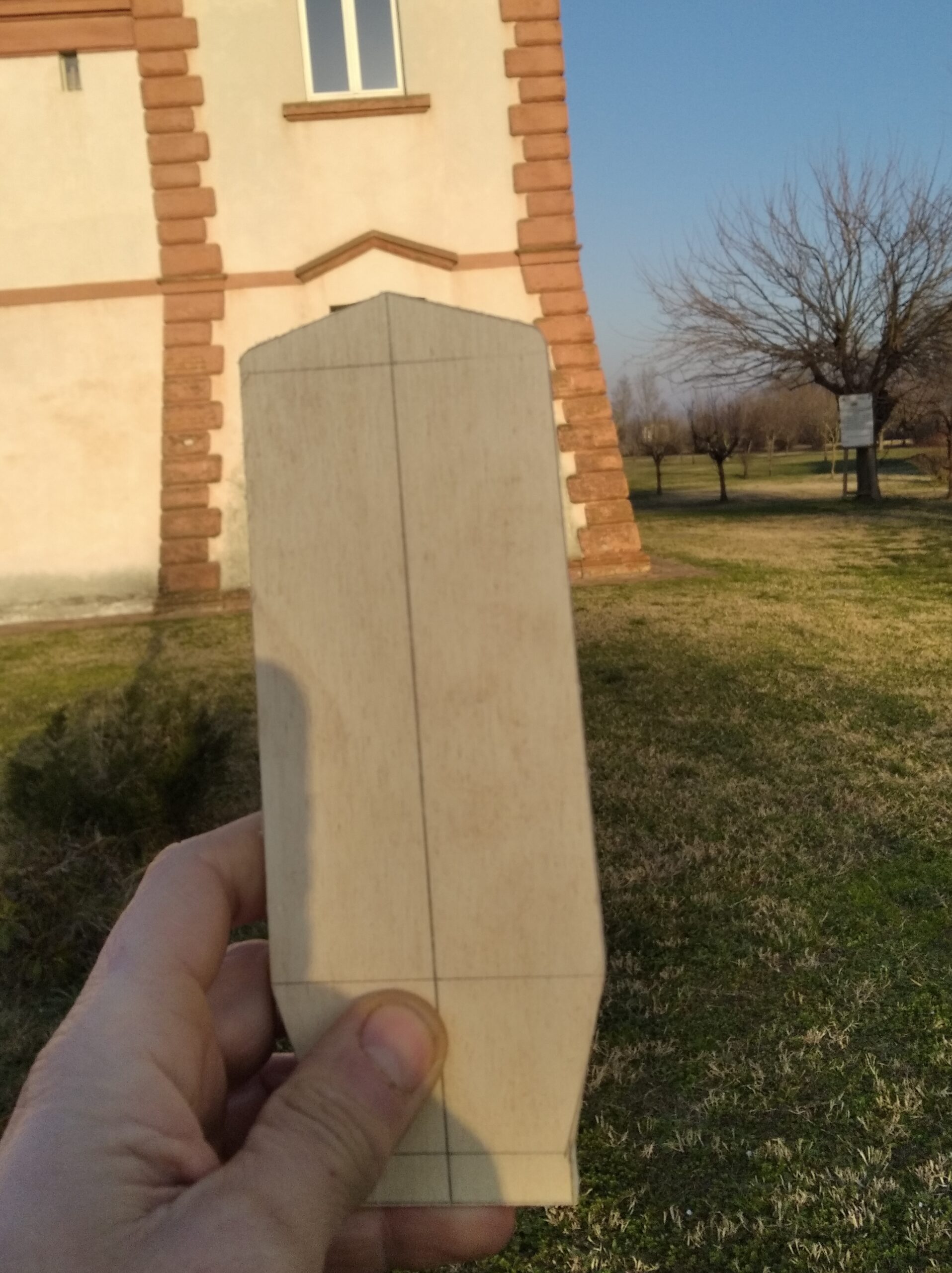
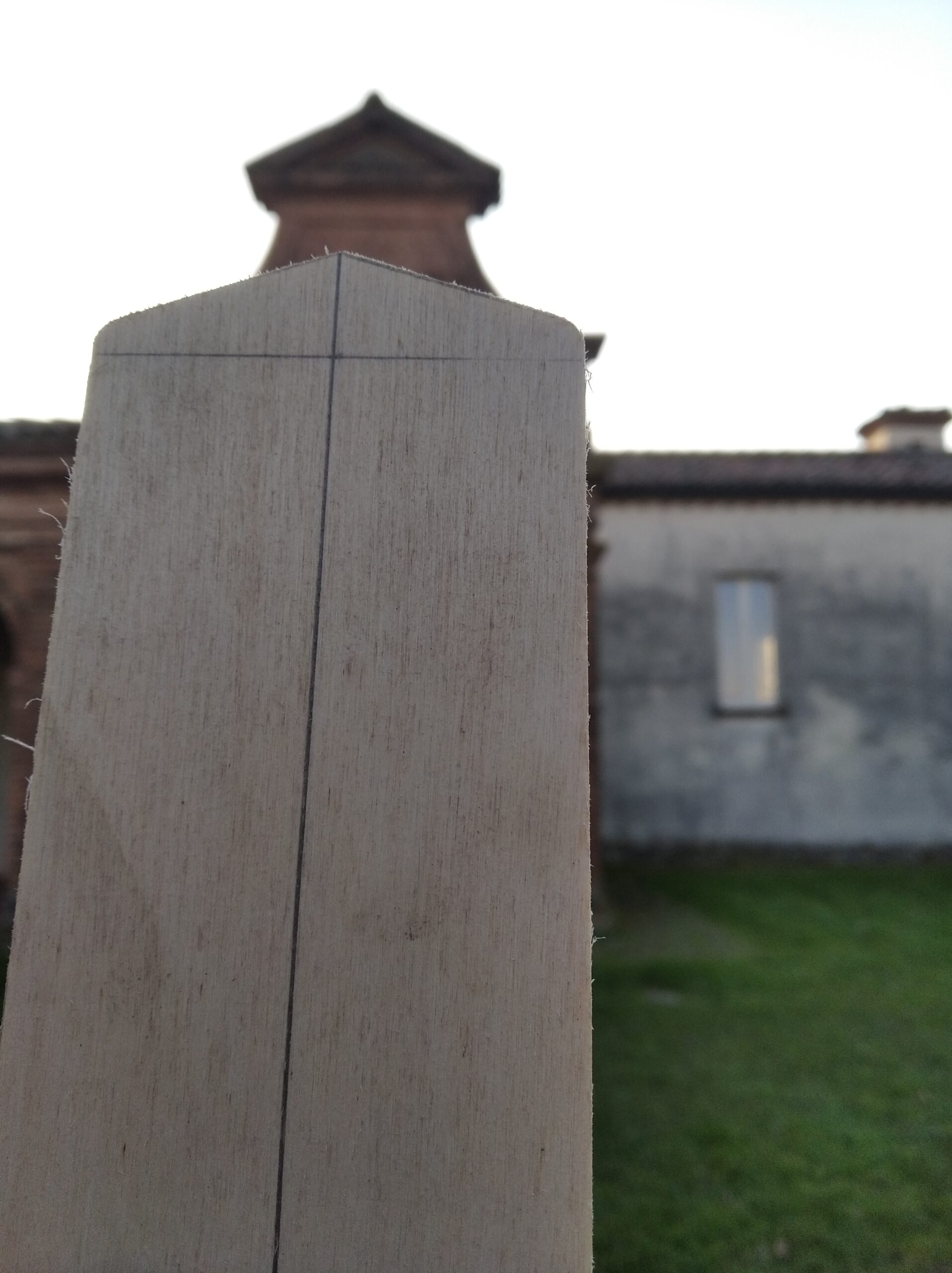
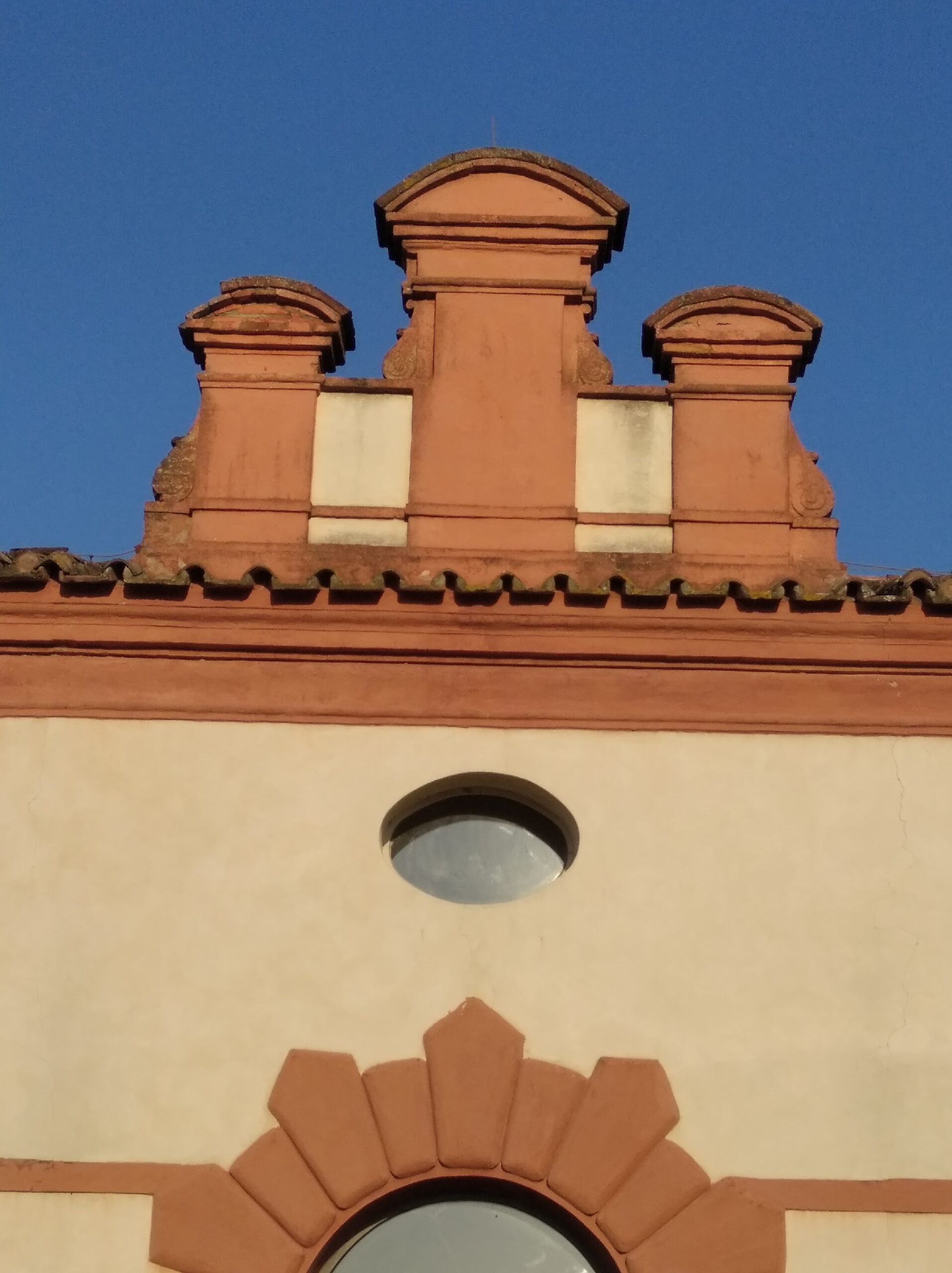 one km from my house, and I turned around and it was all there! The building which most resembled the aesthetics of Maccaferri’s guitars had been sitting under my nose the whole time and I had never noticed it: the spires have a very strange D shape and the door and windows have pointed decorations! The Verginese castle was the country residence of the nobles of Ferrara and is still used today as a logo for local artisan products. We’ll never know for certain, but perhaps Maccaferri, like the Italian violin makers of old, was paying tribute to the land of his birth by imprinting the architectural aesthetics of his region onto his instruments.
one km from my house, and I turned around and it was all there! The building which most resembled the aesthetics of Maccaferri’s guitars had been sitting under my nose the whole time and I had never noticed it: the spires have a very strange D shape and the door and windows have pointed decorations! The Verginese castle was the country residence of the nobles of Ferrara and is still used today as a logo for local artisan products. We’ll never know for certain, but perhaps Maccaferri, like the Italian violin makers of old, was paying tribute to the land of his birth by imprinting the architectural aesthetics of his region onto his instruments.
For more information about Riccardo Mordeglia’s instruments, visit his site at https://www.mordeglia.com/
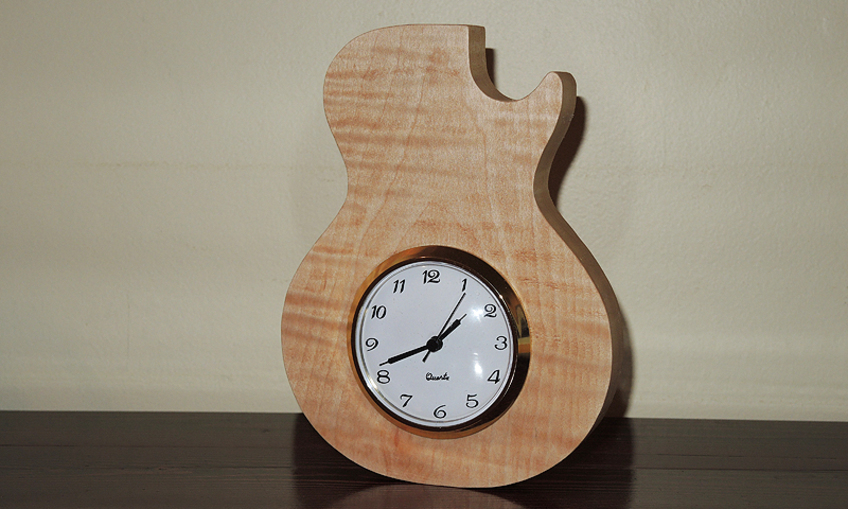
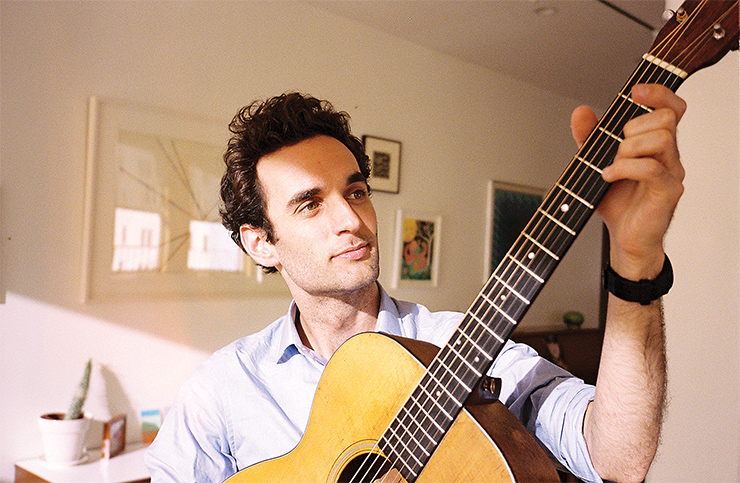
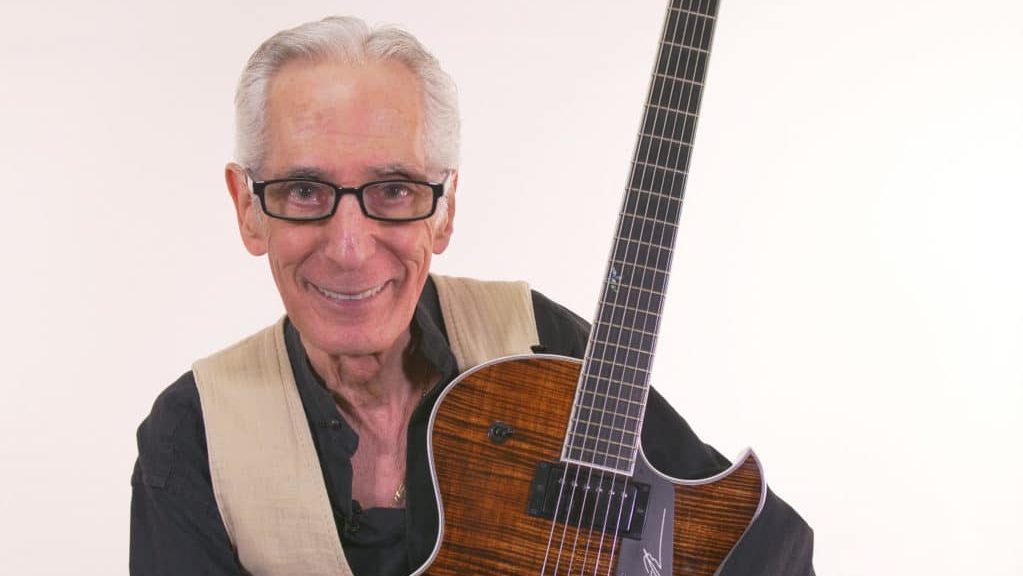
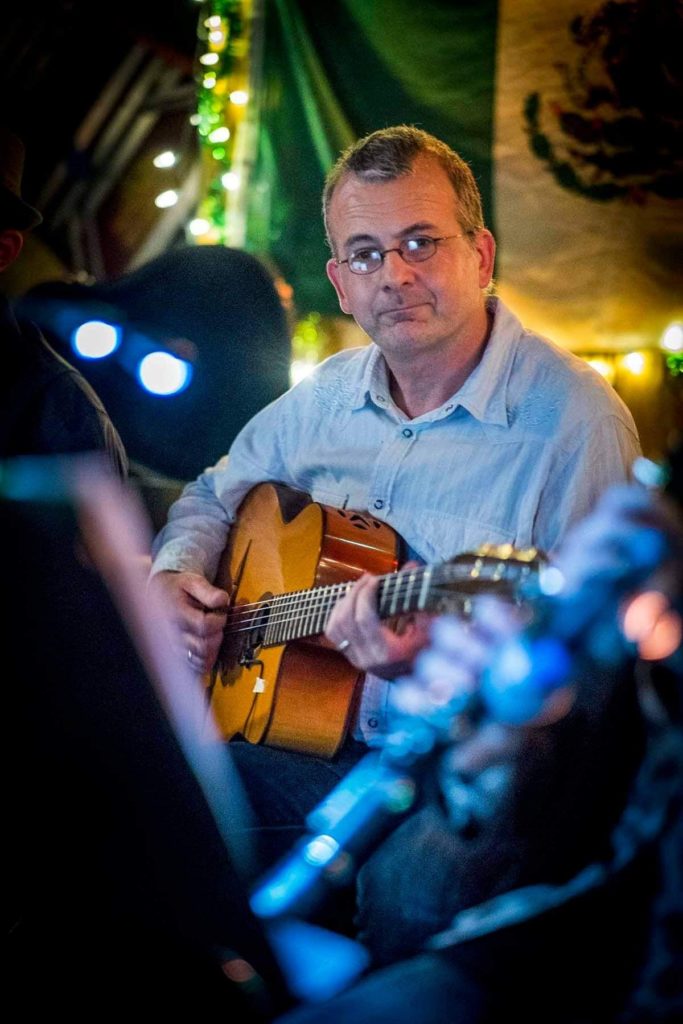
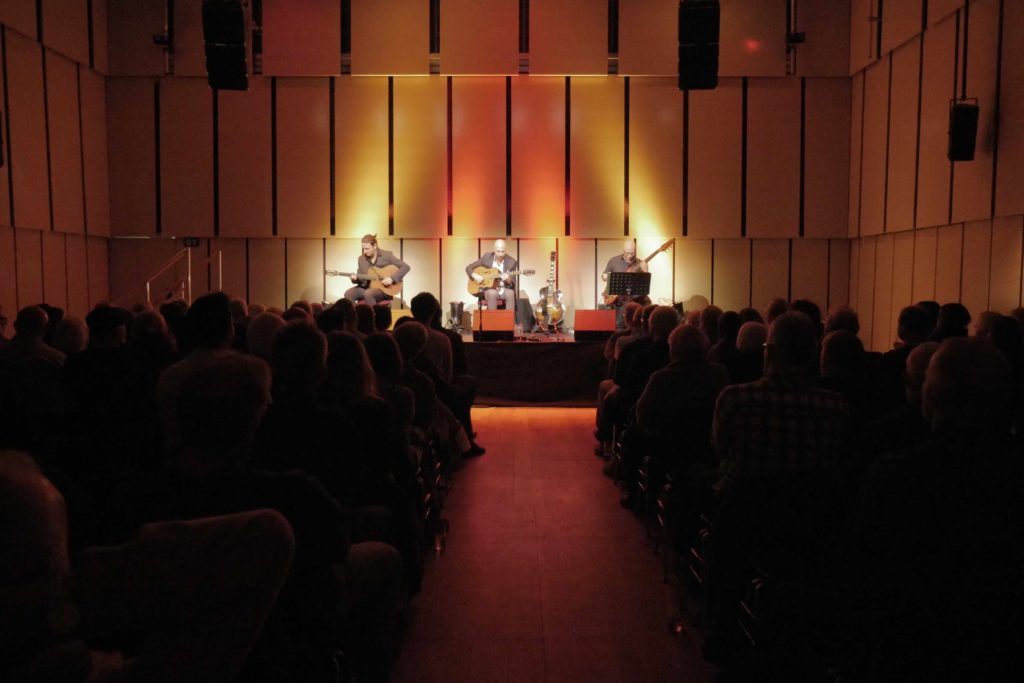
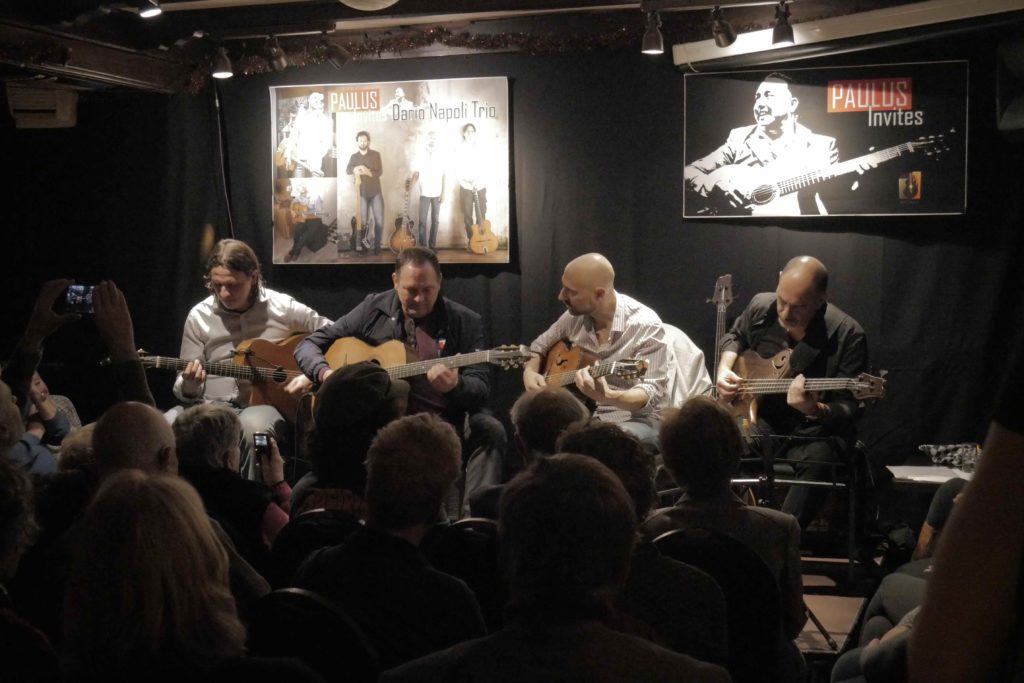
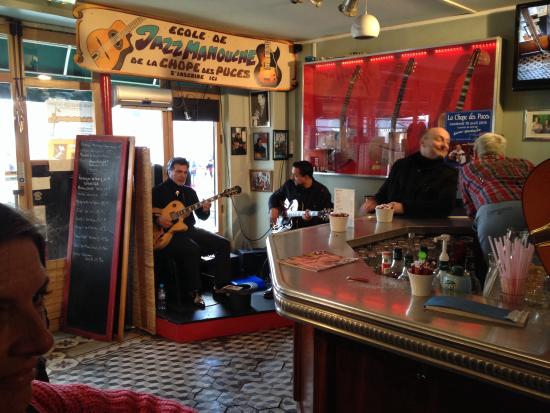
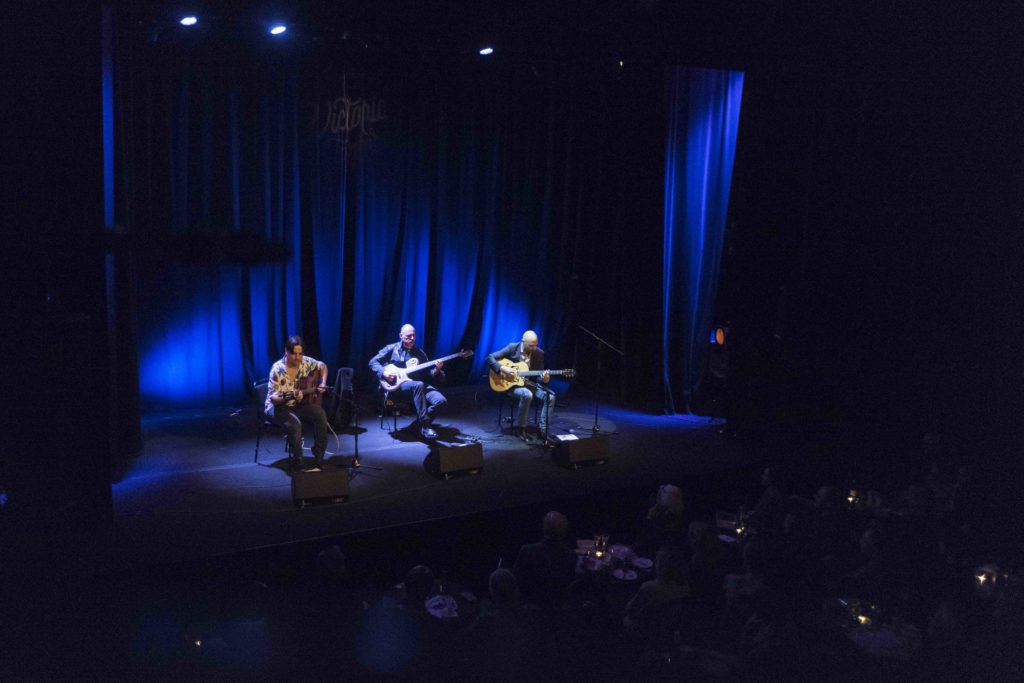
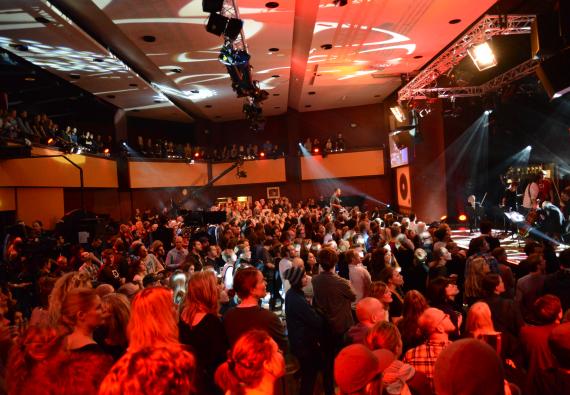
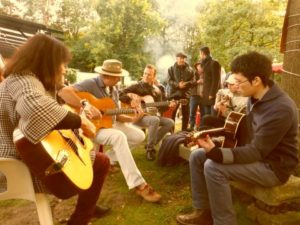
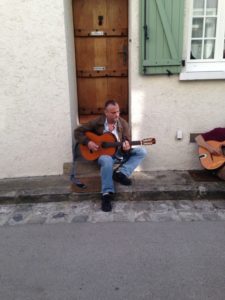
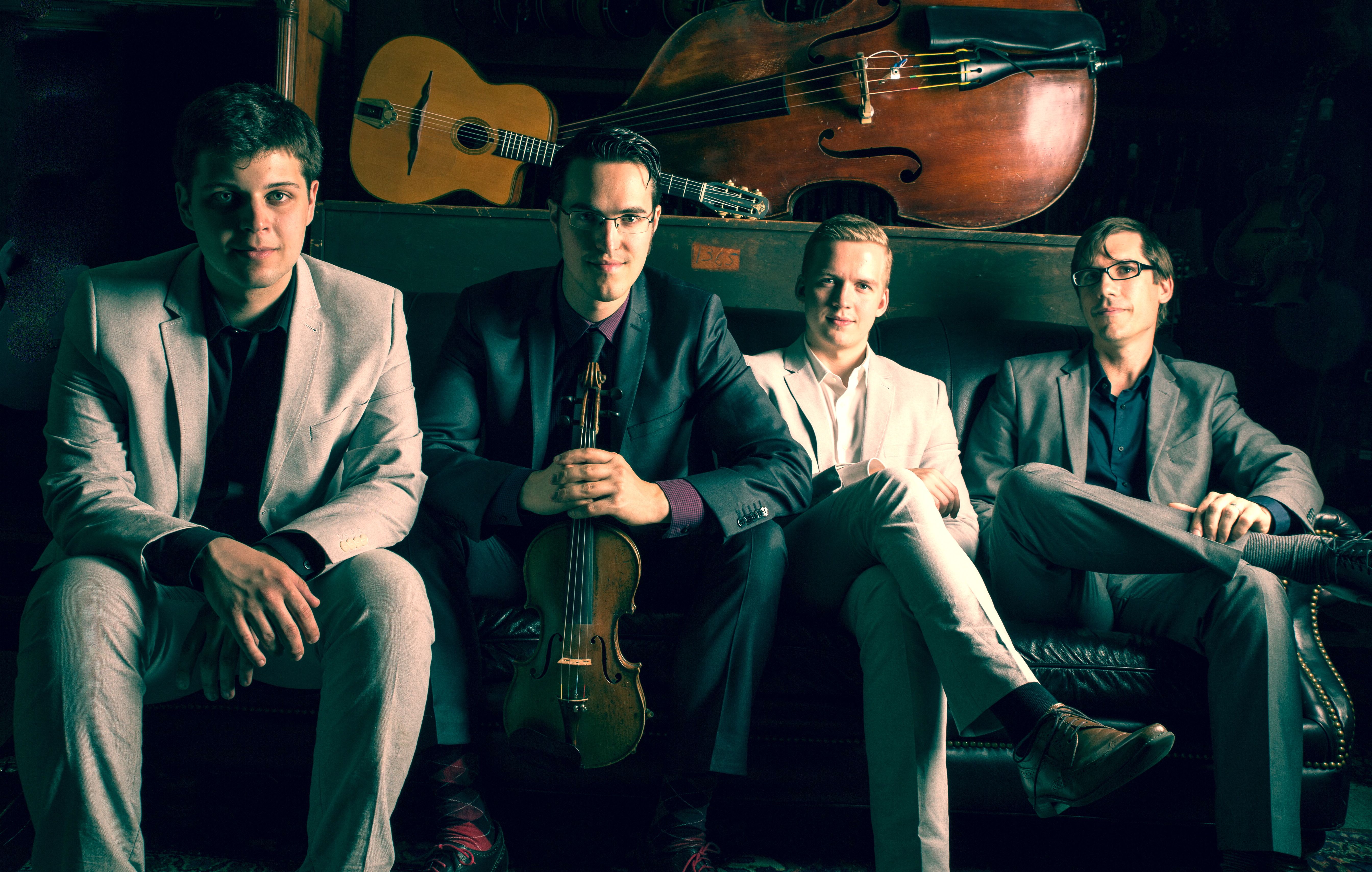 Since their founding, the Rhythm Future Quartet has become one most exciting new Gypsy Jazz bands in America and around the world. Led by Boston based violinist Jason Anick, and Finnish born guitarist, Olli Soikelli (now living in New York City), the band’s new CD Travels takes a big leap from their eponymous self-titled first release. The band has changed personnel from the first release with Max O’Rouke taking over rhythm duties from Vinny Raniolo. There is no doubting the incredible chemistry between Anick and Soikelli, along with O’Rourke and stalwart bassist Greg Loughman. One glance at Travels and what immediately sticks out is the difference between it and their first CD. The first is primarily the band’s arrangements of classic Gypsy Jazz tunes, while the new one is predominantly highly creative originals peppered with some very interesting covers. With a new critically acclaimed album, over a million views on a recent video, and a packed tour schedule, the Rhythm Future Quartet is definitely a group to keep a close eye on!
Here’s the interview with Jason and the band about the past, present, and future, and of course the new CD.
[Dwight]: Do you remember the first time you jammed with Olli?
[Jason]: The first time Olli and I met/jammed was at Django in June back in 2012. We were both instructors at the camp that year. We hit it off right away and discussed collaborating more. Only problem was Olli lived in Finland at the time! Luckily he moved to New York City a year and a half after our initial meeting, which helped pave the way for the Rhythm Future Quartet to be born.
[D]: When was the first time you and Olli shared the stage?
[J]: I believe our first official show together was a pick-up band we assembled for the Brooklyn Gypsy Fest at Shapeshifter Lab in 2012. We did a few more shows together as sidemen with various musicians (Frank Vignola and Nicky Perrot) before we decided to form the RFQ.
[D]: Give us the history of how the actual band was formed.
Since their founding, the Rhythm Future Quartet has become one most exciting new Gypsy Jazz bands in America and around the world. Led by Boston based violinist Jason Anick, and Finnish born guitarist, Olli Soikelli (now living in New York City), the band’s new CD Travels takes a big leap from their eponymous self-titled first release. The band has changed personnel from the first release with Max O’Rouke taking over rhythm duties from Vinny Raniolo. There is no doubting the incredible chemistry between Anick and Soikelli, along with O’Rourke and stalwart bassist Greg Loughman. One glance at Travels and what immediately sticks out is the difference between it and their first CD. The first is primarily the band’s arrangements of classic Gypsy Jazz tunes, while the new one is predominantly highly creative originals peppered with some very interesting covers. With a new critically acclaimed album, over a million views on a recent video, and a packed tour schedule, the Rhythm Future Quartet is definitely a group to keep a close eye on!
Here’s the interview with Jason and the band about the past, present, and future, and of course the new CD.
[Dwight]: Do you remember the first time you jammed with Olli?
[Jason]: The first time Olli and I met/jammed was at Django in June back in 2012. We were both instructors at the camp that year. We hit it off right away and discussed collaborating more. Only problem was Olli lived in Finland at the time! Luckily he moved to New York City a year and a half after our initial meeting, which helped pave the way for the Rhythm Future Quartet to be born.
[D]: When was the first time you and Olli shared the stage?
[J]: I believe our first official show together was a pick-up band we assembled for the Brooklyn Gypsy Fest at Shapeshifter Lab in 2012. We did a few more shows together as sidemen with various musicians (Frank Vignola and Nicky Perrot) before we decided to form the RFQ.
[D]: Give us the history of how the actual band was formed.
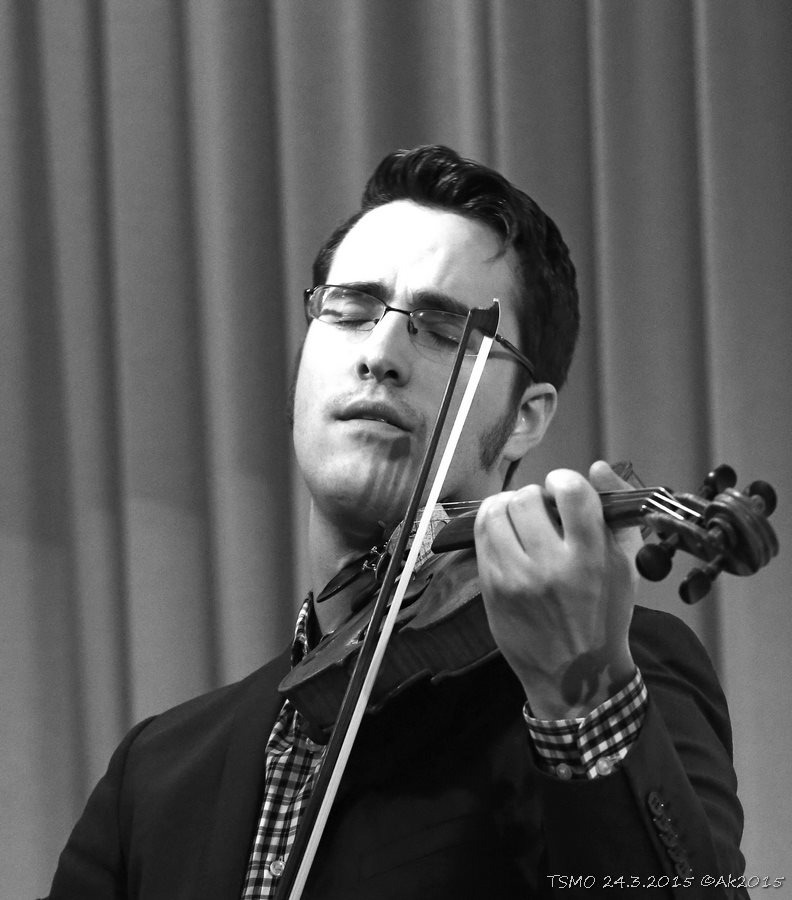 [J]: After Olli and I started playing more and more together, I got a call from Peter Parcek, a Boston based blues guitarist and Django enthusiast, who wanted to put together a Gypsy jazz night at Red Star Union in Cambridge, MA and feature me and Olli. Part of the deal was they did a professional multi-camera shoot of the performance and gave you a copy to use at your own discretion (our version of “Minor Swing” on YouTube was from this show). Olli and I decided that this could be a great way to jump-start a project together, so we assembled a great rhythm section (Vinny Raniolo on guitar and Greg Loughman on bass) and named it the Rhythm Future Quartet. We booked a 5-day tour around the Red Star Union show and it was a huge success. We knew we had something special, the chemistry was there and we had a unique collective vision of where we wanted to take this music. We hit the ground running and haven’t stopped since!
[D]: Give us an idea how you juggle your schedule between your teaching duties at Berklee, playing with John, and of course Rhythm Future.
[J]: It certainly hasn’t been easy juggling everything, but I feel so lucky to have all these great opportunities. It certainly takes good time management and work ethic though.
[D]: As stated, the new CD is quite a departure from the band’s first one. Was this a conscious effort to go for more originals?
[J]: Yes. We released our first album pretty soon after forming the group so that we would have something to sell at shows and start to get our name our there. We were still trying to find our identity as a group, so playing standards with our own arrangements was a way to build a repertoire and start to put our unique stamp on this music. As an avid composer though, I knew in the back of my mind that I wanted our next CD to be mostly centered around original material. As the group continued to tour and grow, we slowly began composing more and more material and eventually headed into the studio to record
[J]: After Olli and I started playing more and more together, I got a call from Peter Parcek, a Boston based blues guitarist and Django enthusiast, who wanted to put together a Gypsy jazz night at Red Star Union in Cambridge, MA and feature me and Olli. Part of the deal was they did a professional multi-camera shoot of the performance and gave you a copy to use at your own discretion (our version of “Minor Swing” on YouTube was from this show). Olli and I decided that this could be a great way to jump-start a project together, so we assembled a great rhythm section (Vinny Raniolo on guitar and Greg Loughman on bass) and named it the Rhythm Future Quartet. We booked a 5-day tour around the Red Star Union show and it was a huge success. We knew we had something special, the chemistry was there and we had a unique collective vision of where we wanted to take this music. We hit the ground running and haven’t stopped since!
[D]: Give us an idea how you juggle your schedule between your teaching duties at Berklee, playing with John, and of course Rhythm Future.
[J]: It certainly hasn’t been easy juggling everything, but I feel so lucky to have all these great opportunities. It certainly takes good time management and work ethic though.
[D]: As stated, the new CD is quite a departure from the band’s first one. Was this a conscious effort to go for more originals?
[J]: Yes. We released our first album pretty soon after forming the group so that we would have something to sell at shows and start to get our name our there. We were still trying to find our identity as a group, so playing standards with our own arrangements was a way to build a repertoire and start to put our unique stamp on this music. As an avid composer though, I knew in the back of my mind that I wanted our next CD to be mostly centered around original material. As the group continued to tour and grow, we slowly began composing more and more material and eventually headed into the studio to record 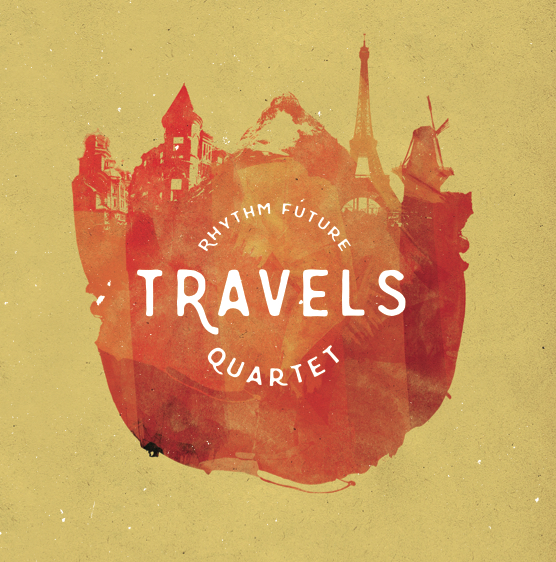
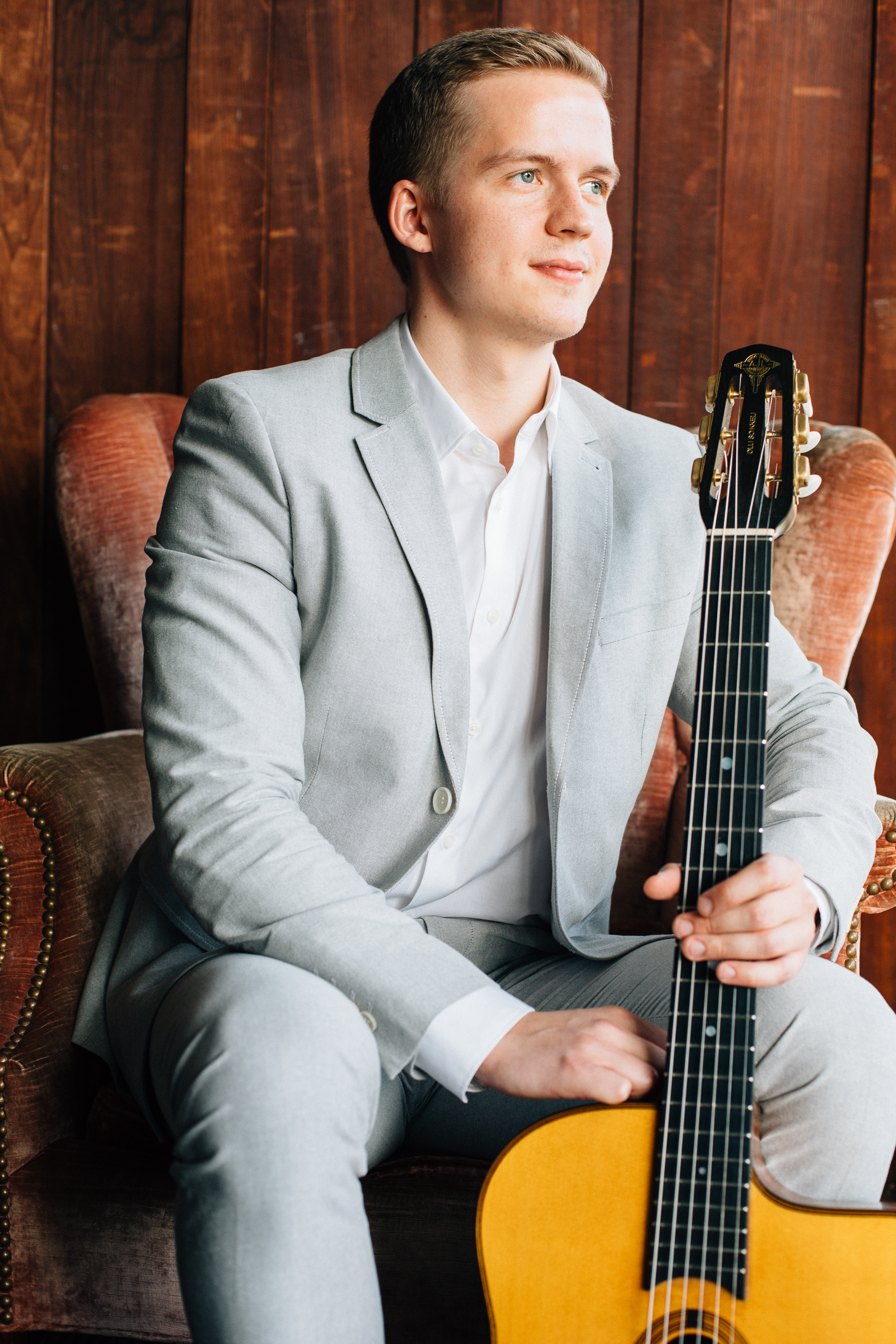 [D]: Tell us about your move to New York- what prompted it and how do you feel it has gone.
[O]: I visited NYC the first time in 2011 when a musician friend of mine who I met at the Pori Jazz festival in Finland, encouraged me to come to NYC and check it out. I fell in love with the city and started to come here at least twice a year doing small gigs in town and performances with guitarists Frank Vignola and Vinny Raniolo. During 2012 and 2013 I was invited to perform at a number of the Django festivals here in US like Django in June, DjangoFest Northwest, and DjangoFest Mill Valley. It was at Django in June that I met Jason and we discussed started a group together. Between starting the Rhythm Future Quartet and all the other musical connections I was making in NYC, I decided to apply for a 3-year artist visa. In 2014 I moved to NYC and already had plenty of work lined up between RFQ and all of the musicians I met from my previous trips to the city.
[D]: What have been some of your more memorable gigs in NYC.
[O]: I did the Django Festival at Birdland with the Schmitt family twice, such an amazing experience playing at the one of the best jazz venues in the world with Gypsy jazz icons. I also got to play at the Lincoln Center with 8-piece jazz band as well as a few times at the Rainbow Room, which is at the top of the Rockefeller Center.
[D]: Tell us what you think the future of gypsy jazz, and where is it going?
[O]: I think Gypsy Jazz has a bright future. A lot of new interesting music is been made and people from other genres are incorporating gypsy jazz in their music. And now especially in NYC there’s a huge boom for hot jazz/swing music and gypsy jazz is right there in the center of that. I feel that even if the Hot Jazz thing doesn’t last forever there’ll always be an audience for Gypsy Jazz because of the virtuosity and the energy the music has.
[Next few questions are for Max O’Rourke]
[D]: Give us a history of your musical development, and how did you get into gypsy jazz.
[Max O’Rourke]: I started taking guitar lessons when I was six, but I didn’t take it seriously until I was about fourteen. When I was around fifteen or sixteen, my teacher at the time showed me Minor Swing and explained a little bit about Django and the way he played. From that point on I was obsessed. That year I enrolled in Django in June, which is where I really learned how to play. Then in 2014 I played my first gig with Gonzalo Bergara and everything just kind of took off after.
[D]: Give us your thoughts on being at Berklee.
[M]: Berklee is one of the most accepting music schools when it comes to stylistic diversity. On any given day at campus you see people playing jazz, metal, bluegrass, folk, etc., so it’s a very encouraging place. I’ve had a few phenomenal teachers there that have really pushed my development as a musician on all fronts, and I owe them a great deal.
[D]: Tell us about your move to New York- what prompted it and how do you feel it has gone.
[O]: I visited NYC the first time in 2011 when a musician friend of mine who I met at the Pori Jazz festival in Finland, encouraged me to come to NYC and check it out. I fell in love with the city and started to come here at least twice a year doing small gigs in town and performances with guitarists Frank Vignola and Vinny Raniolo. During 2012 and 2013 I was invited to perform at a number of the Django festivals here in US like Django in June, DjangoFest Northwest, and DjangoFest Mill Valley. It was at Django in June that I met Jason and we discussed started a group together. Between starting the Rhythm Future Quartet and all the other musical connections I was making in NYC, I decided to apply for a 3-year artist visa. In 2014 I moved to NYC and already had plenty of work lined up between RFQ and all of the musicians I met from my previous trips to the city.
[D]: What have been some of your more memorable gigs in NYC.
[O]: I did the Django Festival at Birdland with the Schmitt family twice, such an amazing experience playing at the one of the best jazz venues in the world with Gypsy jazz icons. I also got to play at the Lincoln Center with 8-piece jazz band as well as a few times at the Rainbow Room, which is at the top of the Rockefeller Center.
[D]: Tell us what you think the future of gypsy jazz, and where is it going?
[O]: I think Gypsy Jazz has a bright future. A lot of new interesting music is been made and people from other genres are incorporating gypsy jazz in their music. And now especially in NYC there’s a huge boom for hot jazz/swing music and gypsy jazz is right there in the center of that. I feel that even if the Hot Jazz thing doesn’t last forever there’ll always be an audience for Gypsy Jazz because of the virtuosity and the energy the music has.
[Next few questions are for Max O’Rourke]
[D]: Give us a history of your musical development, and how did you get into gypsy jazz.
[Max O’Rourke]: I started taking guitar lessons when I was six, but I didn’t take it seriously until I was about fourteen. When I was around fifteen or sixteen, my teacher at the time showed me Minor Swing and explained a little bit about Django and the way he played. From that point on I was obsessed. That year I enrolled in Django in June, which is where I really learned how to play. Then in 2014 I played my first gig with Gonzalo Bergara and everything just kind of took off after.
[D]: Give us your thoughts on being at Berklee.
[M]: Berklee is one of the most accepting music schools when it comes to stylistic diversity. On any given day at campus you see people playing jazz, metal, bluegrass, folk, etc., so it’s a very encouraging place. I’ve had a few phenomenal teachers there that have really pushed my development as a musician on all fronts, and I owe them a great deal.
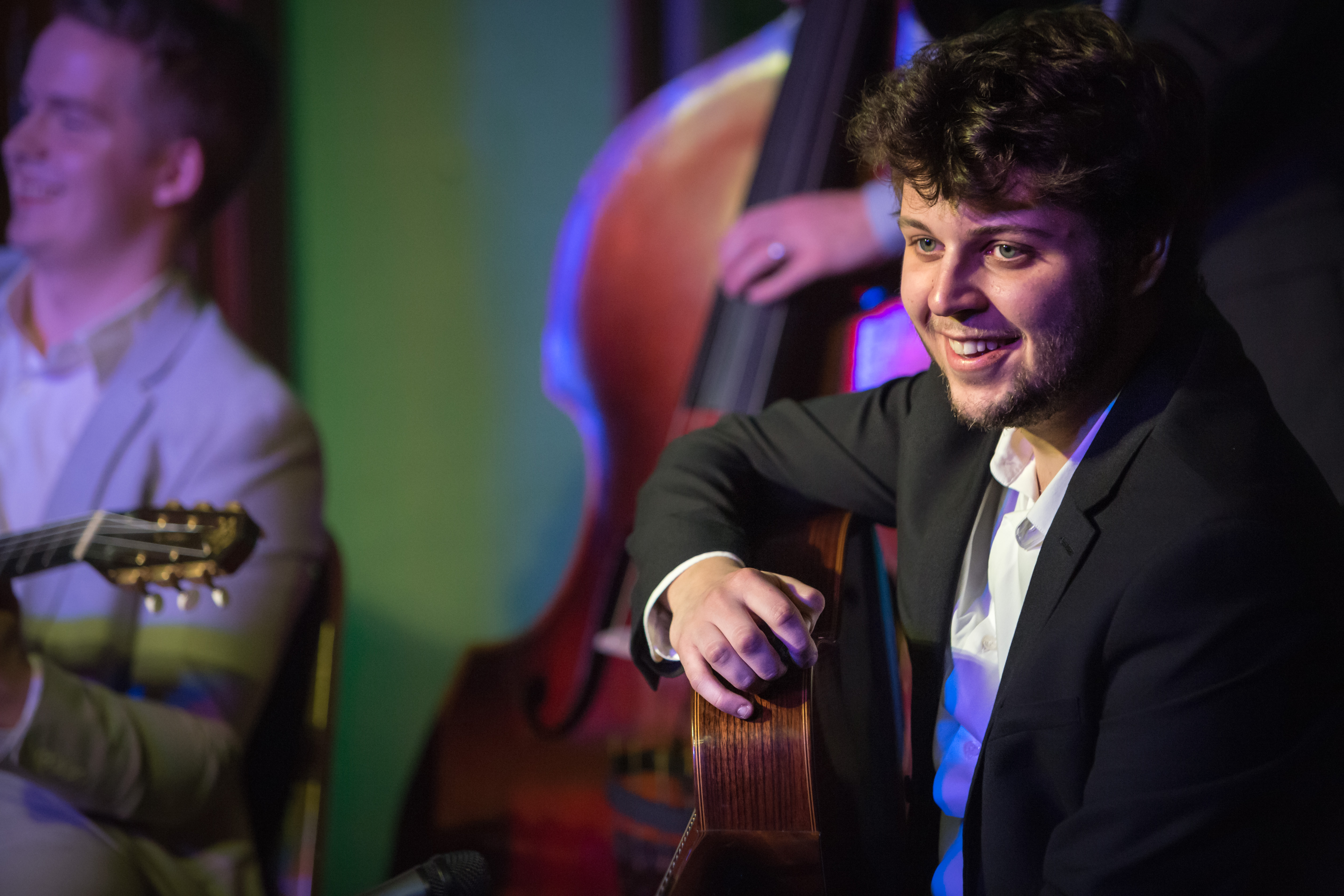 [D]: Who are your influences on the guitar?
[M]: As far as Gypsy jazz players, no list would be complete without starting with Django. Then there’s Biréli Lagrène, Adrien Moignard, and Rocky Gresset. I also really like the way Benoit Convert writes. Gonzalo Bergara has been a tremendous influence and mentor to me as well. Then there are the wonderful rhythm players like Mathieu Chatelain, Hono Winterstein, and Nous’che Rosenberg that are very important to me. Outside of the style, the guitarists I listen to are usually Wes Montgomery, George Benson, Lenny Breau, and Julian Lage. Lately, I also have been listening to a lot of piano players like Bill Evans, Oscar Peterson, and Brad Mehldau.
[D]: What are your plans for the future?
[M]: On top of continuing my work with the RFQ and the GBQ, I have a few things in mind. I was just a part of Daisy Castro’s new album with Quinn Bachand and Brian Netzley, and I’m really looking forward to start touring with them soon. At some point, I’d also like to do an album of my own. I’ve been writing a lot of music lately, and it’d be nice to have something out under my own name.
[Next few questions are for Greg Loughman]
[D]: Give us a history of your musical development.
[Greg Loughman]: I grew up in a small town called Zanesville, OH, where there weren’t a lot of playing opportunities, so I didn’t really start to develop, musically, until I went to college at Capital University in Columbus, OH. After I graduated, I was working enough around Columbus to make a living as a bassist, and have been doing so ever since, most recently in the Boston area. I’ve never stopped learning about different styles of music, mostly jazz and other genres featuring improvisation, but with a lot of interest in music from around the world.
[D]: How did you get into gypsy jazz?
[G]: I met Jason Anick at a jam session in the Boston area, and we started working together on his modern jazz projects. I had always liked gypsy jazz in a general way, but when Jason called me to play with him and Olli Soikkeli on a few gigs around New England, I was instantly hooked and immediately started digging as deeply as I could into the genre. It’s been a great addition to my list of musical interests.
[D]: Who are your influences on the guitar?
[M]: As far as Gypsy jazz players, no list would be complete without starting with Django. Then there’s Biréli Lagrène, Adrien Moignard, and Rocky Gresset. I also really like the way Benoit Convert writes. Gonzalo Bergara has been a tremendous influence and mentor to me as well. Then there are the wonderful rhythm players like Mathieu Chatelain, Hono Winterstein, and Nous’che Rosenberg that are very important to me. Outside of the style, the guitarists I listen to are usually Wes Montgomery, George Benson, Lenny Breau, and Julian Lage. Lately, I also have been listening to a lot of piano players like Bill Evans, Oscar Peterson, and Brad Mehldau.
[D]: What are your plans for the future?
[M]: On top of continuing my work with the RFQ and the GBQ, I have a few things in mind. I was just a part of Daisy Castro’s new album with Quinn Bachand and Brian Netzley, and I’m really looking forward to start touring with them soon. At some point, I’d also like to do an album of my own. I’ve been writing a lot of music lately, and it’d be nice to have something out under my own name.
[Next few questions are for Greg Loughman]
[D]: Give us a history of your musical development.
[Greg Loughman]: I grew up in a small town called Zanesville, OH, where there weren’t a lot of playing opportunities, so I didn’t really start to develop, musically, until I went to college at Capital University in Columbus, OH. After I graduated, I was working enough around Columbus to make a living as a bassist, and have been doing so ever since, most recently in the Boston area. I’ve never stopped learning about different styles of music, mostly jazz and other genres featuring improvisation, but with a lot of interest in music from around the world.
[D]: How did you get into gypsy jazz?
[G]: I met Jason Anick at a jam session in the Boston area, and we started working together on his modern jazz projects. I had always liked gypsy jazz in a general way, but when Jason called me to play with him and Olli Soikkeli on a few gigs around New England, I was instantly hooked and immediately started digging as deeply as I could into the genre. It’s been a great addition to my list of musical interests.
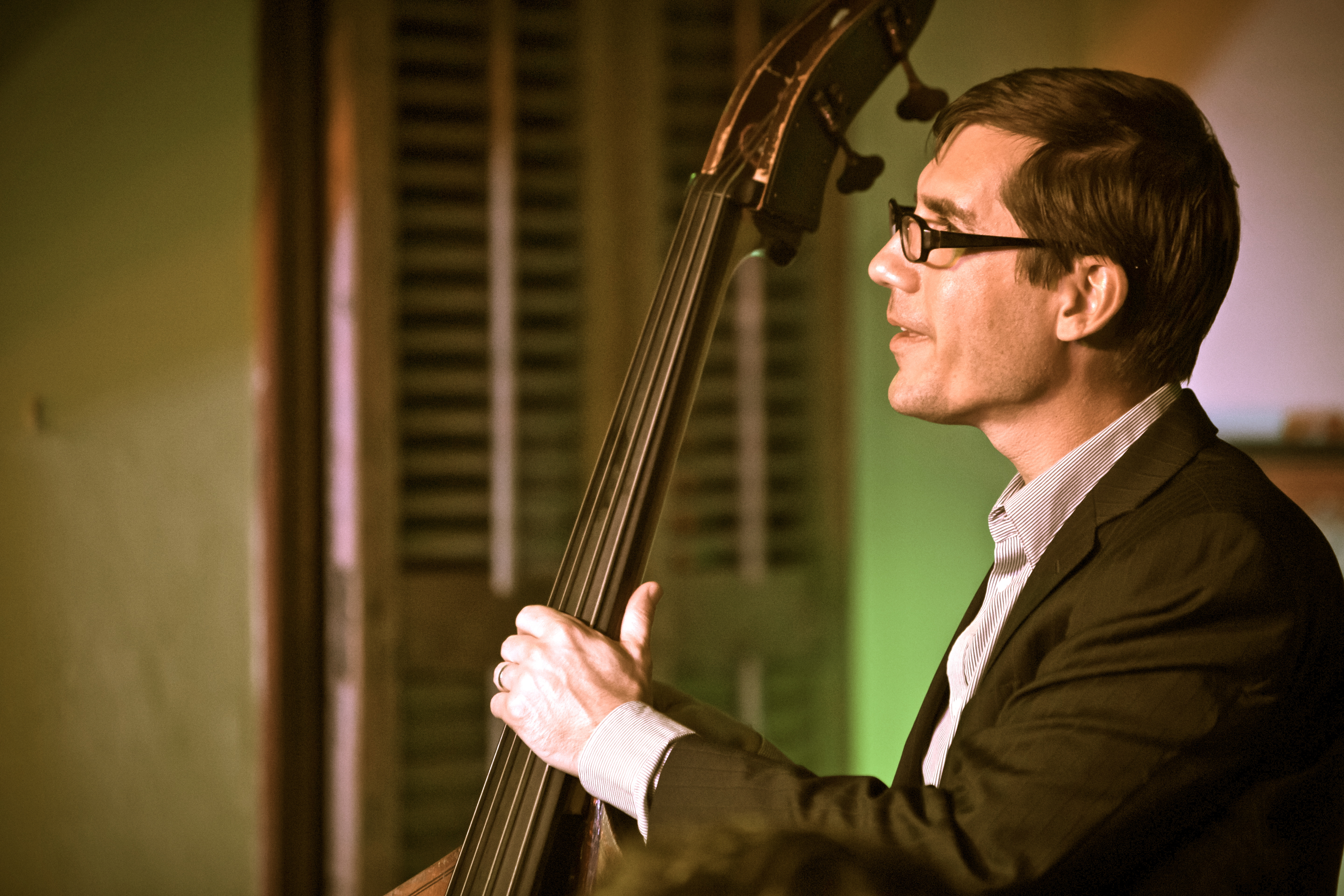 [D]: Who are your influences on the bass?
[G]: In the gypsy jazz genre, I’ve been digging Jérémie Arranger, William Brunard, Diego Imbert a lot lately. They each have their own unique way of playing gypsy jazz in a modern way that still respects the history of the music. That appeals to me as someone who is coming from more of a modern jazz background, and I think it also works well with the more modern gypsy jazz style Rhythm Future leans toward. Outside of the gypsy jazz genre, I’ve checked out a lot of Ray Brown, Paul Chambers, Sam Jones, as well as more modern players like Dave Holland, Scott Colley, Christian McBride, and many others.
[D]: I really enjoy Iberian Sunrise on the new CD- do you write a lot?
[G]: Thanks! I do a fair amount of writing; lately I’ve been writing specifically for the various ensembles I play with, whether it’s the balkan/klezmer band I play with Klezwoods, or my indie rock group Lowman, or the world jazz trio Roving Soul, etc. I knew that Jason, Olli, and Max would be able to take what I wrote into the stratosphere, and they did! One of the thing I love about Rhythm Future is how we all work together to arrange each song; we all have lots of freedom to put our ideas and personal styles into each song, which elevates the band as a whole and makes it more than the sum of it’s parts.
[D]: Ok, final question – tell us what is up for the future of Rhythm Future? Gigs? New Recordings? Collaborations?
[J]: It’s hard to tell what the future will hold, but we are certainly excited and believe there are lots of unique opportunities still ahead of us. We plan on making another record down the road of all original material as well as a doing a live recording/DVD project with some of our friends and fellow musicians from the U.S. and Europe. As for other collaborations, we are open-minded so anything can happen!
[D]: Who are your influences on the bass?
[G]: In the gypsy jazz genre, I’ve been digging Jérémie Arranger, William Brunard, Diego Imbert a lot lately. They each have their own unique way of playing gypsy jazz in a modern way that still respects the history of the music. That appeals to me as someone who is coming from more of a modern jazz background, and I think it also works well with the more modern gypsy jazz style Rhythm Future leans toward. Outside of the gypsy jazz genre, I’ve checked out a lot of Ray Brown, Paul Chambers, Sam Jones, as well as more modern players like Dave Holland, Scott Colley, Christian McBride, and many others.
[D]: I really enjoy Iberian Sunrise on the new CD- do you write a lot?
[G]: Thanks! I do a fair amount of writing; lately I’ve been writing specifically for the various ensembles I play with, whether it’s the balkan/klezmer band I play with Klezwoods, or my indie rock group Lowman, or the world jazz trio Roving Soul, etc. I knew that Jason, Olli, and Max would be able to take what I wrote into the stratosphere, and they did! One of the thing I love about Rhythm Future is how we all work together to arrange each song; we all have lots of freedom to put our ideas and personal styles into each song, which elevates the band as a whole and makes it more than the sum of it’s parts.
[D]: Ok, final question – tell us what is up for the future of Rhythm Future? Gigs? New Recordings? Collaborations?
[J]: It’s hard to tell what the future will hold, but we are certainly excited and believe there are lots of unique opportunities still ahead of us. We plan on making another record down the road of all original material as well as a doing a live recording/DVD project with some of our friends and fellow musicians from the U.S. and Europe. As for other collaborations, we are open-minded so anything can happen!








